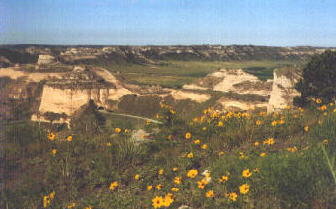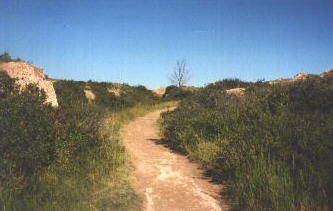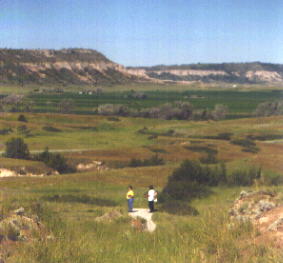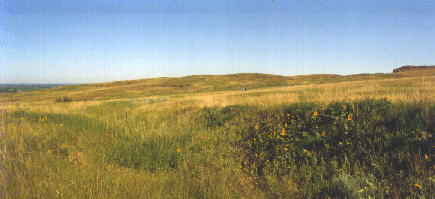Continuing on the Oregon Trail in Western Nebraska
by Lisa Yungel
 6. This is a view that the emigrants didn't see, which is on the top of
Scott's Bluff. Actually, the whole set of bluffs in this picture
are considered Scott's Bluff. The yellow flowers in this picture are a type
of sunflower that grows wild all over the west, even on top of Scott's Bluff.
6. This is a view that the emigrants didn't see, which is on the top of
Scott's Bluff. Actually, the whole set of bluffs in this picture
are considered Scott's Bluff. The yellow flowers in this picture are a type
of sunflower that grows wild all over the west, even on top of Scott's Bluff.
 7. Another view from the top of Scott's Bluff shows how vast the prairie
was in this area. The light green plant in the front left of the picture is
sage. If you rub your hand over sage it releases a smell which is rather
nice. The west is so full of sage that, by this point in their journey, most
emigrants wrote that they hated it's aroma.
7. Another view from the top of Scott's Bluff shows how vast the prairie
was in this area. The light green plant in the front left of the picture is
sage. If you rub your hand over sage it releases a smell which is rather
nice. The west is so full of sage that, by this point in their journey, most
emigrants wrote that they hated it's aroma.
 8. This is the Oregon Trail as it narrowed down to one wagon lane through
Scott's Bluff.
8. This is the Oregon Trail as it narrowed down to one wagon lane through
Scott's Bluff.
 9. You can see the grassy ruts on this picture by looking at how high the
ground is on either side of the picture. If the grass were cut from the
center of this swale the ruts would be 3-4 feet deep.
9. You can see the grassy ruts on this picture by looking at how high the
ground is on either side of the picture. If the grass were cut from the
center of this swale the ruts would be 3-4 feet deep.
 10. If you look at the small sunflowers in this picture, you can see how
the grassy ruts curves from the center-left of the picture out to the right.
If you'll look in the distance, you'll see a dark and light blue dot which are
people walking on the Oregon Trail. The emigrants often wrote in their
journals about how deceptive distance seemed when looking across the
prairies. For instance, these people are about a mile away from the person
taking the picture, yet it seems a lot closer.
10. If you look at the small sunflowers in this picture, you can see how
the grassy ruts curves from the center-left of the picture out to the right.
If you'll look in the distance, you'll see a dark and light blue dot which are
people walking on the Oregon Trail. The emigrants often wrote in their
journals about how deceptive distance seemed when looking across the
prairies. For instance, these people are about a mile away from the person
taking the picture, yet it seems a lot closer.
 11. This picture was taken in Craters of the Moon National Park in Idaho.
What does it have to do with the Oregon Trail? Well, one of the shortcuts
called cutoffs, from the Trail went along the edge of the hills in the
background. These cutoffs were meant to save the emigrants time and
miles, however, many cutoffs went through areas where grass and water
were scarce, which is true of the area in this picture. The
strange formations that you see in the front of the picture are
actually lava formations from extinct volcanos in the area. In fact, one
of the major problems with cutoffs can be seen in this picture: if you look
at the hills in this picture, what color do the hills look to you? They look
green to me, as they did to the emigrants. Unfortunately, the green color
does not come from plant life as we might think but from minerals in the
ground. Many emigrants traveled toward these hills thinking the green
color offered their oxen, horses, and other animals grass and water,
only to be disappointed. The emigrants (and their animals) usually found
out the hard way that cutoffs, while they might save miles, could mean
disaster.
11. This picture was taken in Craters of the Moon National Park in Idaho.
What does it have to do with the Oregon Trail? Well, one of the shortcuts
called cutoffs, from the Trail went along the edge of the hills in the
background. These cutoffs were meant to save the emigrants time and
miles, however, many cutoffs went through areas where grass and water
were scarce, which is true of the area in this picture. The
strange formations that you see in the front of the picture are
actually lava formations from extinct volcanos in the area. In fact, one
of the major problems with cutoffs can be seen in this picture: if you look
at the hills in this picture, what color do the hills look to you? They look
green to me, as they did to the emigrants. Unfortunately, the green color
does not come from plant life as we might think but from minerals in the
ground. Many emigrants traveled toward these hills thinking the green
color offered their oxen, horses, and other animals grass and water,
only to be disappointed. The emigrants (and their animals) usually found
out the hard way that cutoffs, while they might save miles, could mean
disaster.
Search The Global Classroom
Patricia A. Weeg
pweeg@shore.intercom.net
Return to Global Classroom






